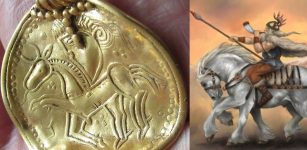Horrifying Flying Head That Terrorized The Iroquois
Ellen Lloyd - AncientPages.com - The Iroquois have an interesting legend about a horrifying flying that terrorized people for no apparent reason. This was no ordinary head of a normal person. The head was huge, about four times larger than the size of a man. This bodyless creature had great wings protruding from its cheeks.
Lurking in the forest the monster was coated in thick black hair and its mouth was filled with fangs. It ate everything that was alive, including humans.
What is interesting and slightly unusual about this Native American monster is that it seems to have vanished into thin air. The flying head was seen by many but then it simply disappeared, and no one knows what happened to it.
In Native American mythology, there are many accounts of dangerous flying animals. The legendary thunderbird was admired and feared by the Indians. There are different legends about the thunderbird, but most tribes say that the powerful and magnificent Thunderbird was sent by the Gods to protect humans from evil. When this huge, eagle-like bird soared the skies, one could hear its mighty wings beat with the sound of rolling thunder. Its eyes were burning like fire and caused lighting.
In myths of Penobscot people of Maine, the thunderbird is known as Pamola. In ancient beliefs of these people, Pamola (means: "he curses on the mountain") is said to be the god of Thunder and guardian of Mt Katahdin (“The Greatest Mountain”), the highest mountain in the U.S. state of Maine at 5,267 feet (1,605 m).
We should also not forget about the mysterious Piasa bird, a dragonlike creature that according to natives, existed thousands of moons before the pale face came.
The story of the flying head of the Iroquois is different because there were very few sightings of this dangerous creature.
Legends tell one day a man spotted the flying head soaring through treetops. It seemed to be nothing more than a shadow but it was glowing brightly. He hurried back to the village and told everyone to leave as fast as they could. Everyone left, except for a woman who stayed there with her baby.
“The woman sat beside the hearth and built the fire up into a great blaze, then heated some stones to a red-hot glow. Suddenly the Flying Head appeared, its horrible mouth slavering as it looked into the longhouse from the far end. Not giving any sign that she noticed it, the young woman began to pretend she was eating a meal. She picked up the red-hot rocks with a forked stick and pretended to put them in her mouth. With each “bite,” she said how good it tasted, what a wonderful meal it was.
Flying Head defeated by woman roasting acorns. Copy of a traditional Iroquois painting. - Alexander, Hartley Burr. The Mythology of All Races, Vol. Ten: North American. Boston: Marshall Jones, 1916. Credit: Public Domain
The monster watched, growing hungrier and hungrier, his horrid mouth drooling until he could wait no longer. He stuck his head far into the longhouse and swallowed the entire heap of burning rocks. A horrible scream pierced the night, and another, and the monster frantically beat its wings and flew off into the dark, screaming in agony and rage. He screamed so loud that the trees he flew past all trembled.
People scattered here and there in the forest fell to the ground, covering their ears. The monster kept screaming as he flew farther and farther away from the longhouse, until his screams could be heard no longer, and the people rose up from the ground and went home, finally safe.” 1
The origin of the flying head remains a mystery. Some think the head belongs to a murder victim. According to other Native American beliefs, a human is transformed into a flying head after committing an act of cannibalism.
According to both Iroquois and Wyandot mythology, flying heads are ravenous spirits, that are cursed with an insatiable hunger. Sometimes flying heads are also associated with whirlwinds.
As previously mentioned the flying head that terrorized the Iroquois came and vanished without a trace. What happened to it is unknown. Some think it died, thought it unlikely if it was a spirit. Another option is that is it still, as some of the Iroquois think went to the sea. Perhaps it is now hunting creatures that reside underwater.
Written by Ellen Lloyd – AncientPages.com
Copyright © AncientPages.com & Ellen Lloyd All rights reserved. This material may not be published, broadcast, rewritten or redistributed in whole or part without the express written permission of AncientPages.com and Ellen Lloyd
Expand for referencesMore From Ancient Pages
-
 Unexpected Discovery Reveals People Arrived In North America 20,000 Years Earlier Than Previously Thought
Archaeology | Jun 5, 2021
Unexpected Discovery Reveals People Arrived In North America 20,000 Years Earlier Than Previously Thought
Archaeology | Jun 5, 2021 -
 1,700-Year-Old Roman Villa, Beautiful Mosaics, Coins Unearthed In Ancient Roman Port Of Ptolemais
Archaeology | Jun 12, 2017
1,700-Year-Old Roman Villa, Beautiful Mosaics, Coins Unearthed In Ancient Roman Port Of Ptolemais
Archaeology | Jun 12, 2017 -
 On This Day In History: Raid On The Medway Took Place – On June 19, 1667
News | Jun 19, 2016
On This Day In History: Raid On The Medway Took Place – On June 19, 1667
News | Jun 19, 2016 -
 Evidence Ancient Civilizations Had Knowledge About Planets In Our Solar System Thousand Years Ago
Ancient Mysteries | Mar 10, 2021
Evidence Ancient Civilizations Had Knowledge About Planets In Our Solar System Thousand Years Ago
Ancient Mysteries | Mar 10, 2021 -
 Ancient Artifacts With Puzzling Signs Found In North America May Be Evidence Of A Lost Civilization Or Unknown Native American Tribe
Featured Stories | Feb 4, 2025
Ancient Artifacts With Puzzling Signs Found In North America May Be Evidence Of A Lost Civilization Or Unknown Native American Tribe
Featured Stories | Feb 4, 2025 -
 Early Humans In Europe Were Making Fires At Least 250,000 Years Ago – New Study
Archaeology | May 18, 2023
Early Humans In Europe Were Making Fires At Least 250,000 Years Ago – New Study
Archaeology | May 18, 2023 -
 Did The Inca Use The Quipu To Collect Taxes?
Archaeology | Jun 24, 2019
Did The Inca Use The Quipu To Collect Taxes?
Archaeology | Jun 24, 2019 -
 Roman Naval Base of Haltern in Germany Was Rebuilt Four Times 2,000 Years Ago
Archaeology | May 8, 2023
Roman Naval Base of Haltern in Germany Was Rebuilt Four Times 2,000 Years Ago
Archaeology | May 8, 2023 -
 Is A Viking Settlement And Even Older Church Hidden Under St. Clement’s Church In Norway?
Archaeology | Apr 13, 2017
Is A Viking Settlement And Even Older Church Hidden Under St. Clement’s Church In Norway?
Archaeology | Apr 13, 2017 -
 Controversial Unexplained Ancient Mystery In Mongolia – Discovery Of Remarkable Secrets Hidden In Artificial Cave – Part 1
Ancient Mysteries | May 1, 2018
Controversial Unexplained Ancient Mystery In Mongolia – Discovery Of Remarkable Secrets Hidden In Artificial Cave – Part 1
Ancient Mysteries | May 1, 2018 -
 Mystery Of Doppelgangers And Spirit Doubles – From Ancient To Modern Times
Featured Stories | Sep 16, 2014
Mystery Of Doppelgangers And Spirit Doubles – From Ancient To Modern Times
Featured Stories | Sep 16, 2014 -
 Forgotten Notebook Reveals Da Vinci Understood Gravitiy Long Before Newton
Ancient Technology | Feb 22, 2023
Forgotten Notebook Reveals Da Vinci Understood Gravitiy Long Before Newton
Ancient Technology | Feb 22, 2023 -
 Discovered Gold Pendant Of Odin And His Horse Sleipnir Might Be Linked To The Heruli Tribe
Archaeology | Apr 16, 2016
Discovered Gold Pendant Of Odin And His Horse Sleipnir Might Be Linked To The Heruli Tribe
Archaeology | Apr 16, 2016 -
 Legend Of Tarenyawagon Who Came From The Heavens And Ascended To The Stars In His Fast Flying Shining Canoe
Ancient Mysteries | Feb 25, 2019
Legend Of Tarenyawagon Who Came From The Heavens And Ascended To The Stars In His Fast Flying Shining Canoe
Ancient Mysteries | Feb 25, 2019 -
 Earliest Document Written 2,100 Years Ago May Rewrite History Of The Basque Language
Archaeology | Nov 17, 2022
Earliest Document Written 2,100 Years Ago May Rewrite History Of The Basque Language
Archaeology | Nov 17, 2022 -
 Kiln Was Invented In Mesopotamia Around 6,000 B.C.
Ancient History Facts | Mar 7, 2018
Kiln Was Invented In Mesopotamia Around 6,000 B.C.
Ancient History Facts | Mar 7, 2018 -
 Long-Lost Burial Site Of Viking King Harald Bluetooth Discovered By Satellites?
Archaeology | Jun 29, 2022
Long-Lost Burial Site Of Viking King Harald Bluetooth Discovered By Satellites?
Archaeology | Jun 29, 2022 -
 1,900-year-old ‘water law’ unearthed in Laodicea
Civilizations | Aug 26, 2015
1,900-year-old ‘water law’ unearthed in Laodicea
Civilizations | Aug 26, 2015 -
 On This Day In History: Tunguska Explosion: Mysterious And Ferocious Impact In Remote Siberia – On June 30, 1908
News | Jun 30, 2016
On This Day In History: Tunguska Explosion: Mysterious And Ferocious Impact In Remote Siberia – On June 30, 1908
News | Jun 30, 2016 -
 Still Intact 460-Year-Old Bow Found Underwater In Alaska Baffles Scientists – Where Did It Come From?
Archaeology | Mar 17, 2022
Still Intact 460-Year-Old Bow Found Underwater In Alaska Baffles Scientists – Where Did It Come From?
Archaeology | Mar 17, 2022


